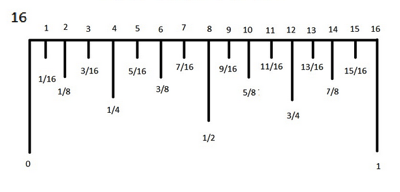THETR 151
Reading an Inch Ruler
A typical inch ruler has each inch divided into 16 segments (some may have 1/32, or even 1/64, but we are only concerned with 1/16)
Be sure you are looking at the inch scale and not the centimeter scale. The part of you architect's scale ruler that has the number 16 at the end also looks like this.
The divisions have a visual cue, as well, to make the ruler easier to read. The largest division, 1/2", has the longest line. The lines at each rank get shorter, ie: 1/4 is shorter than 1/2; 1/8 is shorter than 1/4; and 1/16 is shorter than 1/8.
Fractions have two parts, the numerator and the denominator. The denominator is the bottom number and it tells us what unit of fraction we are working with (ie: it denotes fourths, halves, etc.) The numerator tells us how many of that unit of fraction we are dealing with (ie: it enumerates how many fourths, halves, etc.)
The symbol for fractions of inches when writing them is the quote mark, " after the fraction. So 1/4 of an inch is written 1/4".
Fractions need to be reduced when writing them down. It is accurate to say that one half of an inch is 4/8, but it is incorrect to write it that way. To reduce a fraction, divide both the numerator and denominator by two, continuing until the numerator is an odd number. For example 4/8, 2/4, 1/2. One is an odd number, so 1/2 is reduced as far as it can be. Again, 12/16, 6/8, 3/4. Three is an odd number so the fraction has been reduced as far as it can go.
To add or subtract fractions, you need a lowest common denominator. for example, to add 1/2 and 1/4, you need a common denominator. 1/2" equals 2/4", so 4 is our common denominator. Therefore 2/4" + 1/4" = 3/4".
Subtraction works the same way: 7/8" - 3/16"= 14/16" - 3/16" = 11/16".
Fractions more than an inch are written: 1 3/16" or 5 3/8".
Fractions more than an inch are compound fractions and must be reduced to add or subtract.
1 3/16" + 2 1/2 = ?
You could convert everything to fractions with lowest commpn denominators, add them, and reduce, or
Reduce the fractions, add the whole numbers, and then add the fractions: 1 3/16" + 2 4/16" = 3 7/16"

